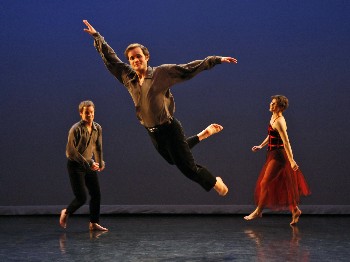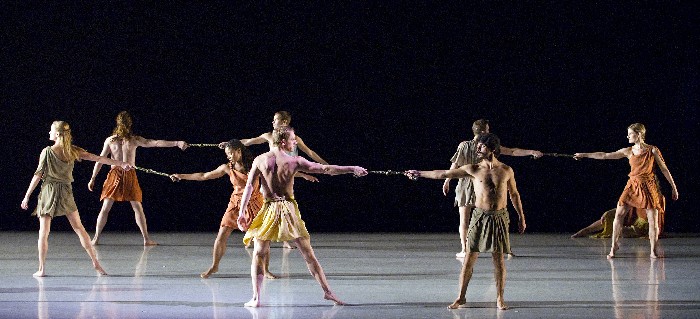Dance Review: Mark Morris Redux
Mark Morris, no longer dancing, joined his company for the curtain call. He’s beloved here, a part of the contemporary dance scene in Boston over the decades as a performer, a choreographer for the Boston Ballet, a teacher, and an inspiration to a number of local performers.
Mark Morris Dance Group. Presented by the Celebrity Series of Boston at the Cutler Majestic Theatre, Boston, MA, through May 20.
By Iris Fanger
There are times when an evening’s worth of dances by Mark Morris and his estimable Dance Group are too much to comprehend, at least in a review. Each performance is filled with so many elements to consider: the choreography, the musical qualities, the variety of themes as well as the types of subject matter.
First, there’s articulating the artistic connections between the dances and the music, which is performed by musicians and singers in the pit. Having live music for his dances has become one of Morris’s trademarks, and his taste in musicians is as expert as his ear for a stylistically wide range of composers. For this evening of Boston premieres, he choose to stay in the classical mode: Beethoven, Johann Nepomuk Hummel, and Erik Satie.
The first two works on the program, The Muir (Beethoven) and Festival Dance (Hummel) 2011, are similar, gambols through the playing fields of life, love, and, in the first piece, experiences of darkness. (The Muir was created for the 2010 Tanglewood Festival, which I attended.) The final work, Socrates, 2010, was a radical change in pace, the stage picture shifting from happy folk to ancient Greece, where 15 toga-clad dancers replicate the death of the philosopher accompanied by Satie’s music, which is set to texts taken from Plato’s Symposium and Phaedo.
In The Muir, Morris used suggestions from Beethoven’s arrangement of nine folk songs to create vignettes about young people meeting, greeting, and casually passing their days. A sextet of dancers met in various configurations: duets, trios, and full cast, their gestures and emotions occasionally mirroring the lyrics of the songs. Morris, who performed with a Balkan folk dance ensemble as a teenager in Seattle, employs familiar motifs, such as a dipping and bending troika formation with the dancers raising one leg in unison over the other and a clasping of hands as they circle round. But Morris departs from folk dance in the inventive lifts he creates for the group, women (and sometimes men) hoisted onto shoulders as if they were figureheads on a sailing ship or slung across hips and backs. The images are held but for a moment, suggesting that they are fragments of a dream. Laurel Lynch was the saucy Sally (“Sally in our alley”) supported by two men. Company stalwart Michelle Yard performed a weighted solo. The songs were performed by soprano Kristen Watson, tenor Matthew Anderson, and baritone Michael Kelly. They were accompanied by the marvelous pianist Colin Fowler, violinist Georgy Valtchev, and cellist Paul Wiancko.
Festival Dance is exactly that, a rousing piece for 12 dancers with Rita Donahue and Aaron Loux as the lead couple followed by Lynch and William Smith III for the andante March. A long chain dance is broken up by hopping steps and then a series of turns and tiny jumps as the performers enter from either side of the stage: the theme and variations generate pleasure and then joy by the final Rondo, which at this performance elicited cheers from the audience when it ended.
But it’s the stately, elegiac Socrates that resonates the most powerfully. Fifteen dancers move in procession throughout the piece, often dropping to the floor in reclining poses reminiscent of the gods and goddesses at rest on the frieze of the Parthenon or raising one hand with forefinger pointed up, as if to underline a thought. The even tempo of the music, performed by Fowler and sung by Kelly, is as steady and seamless as the horizontal steps the dancers take from the left of the stage to the right. The work opens with one dancer in silhouette against a white portion of the black backdrop, an effective foil to the pale-colored tunics worn by the dancers, who sometimes add cloaks to expand their presence further into the space. At the end, the dancers drop to the floor in homage to Socrates’s death. However, one woman lives to escape to the wings. Could it be a sign of hope for the renewal of the life of the mind?
Morris, no longer dancing, joined his company for the curtain call. Although he is based in New York, Morris is beloved here: a part of the contemporary dance scene in Boston over the decades as a performer, a choreographer for the Boston Ballet, a teacher, and an inspiration to a number of local performers.
The Mark Morris Dance Troupe will appear at Tanglewood Music Festival June 28 through 29.



Thanks for leading me to your reviews. I especially like Mark Morris’ first piece The Muir. It looked original to me because I am not as experienced as you are.
I also read your review of the Boston Ballet. I have seen them three times
this season and this was the least interesting of the performances. Your comments resonated with me.